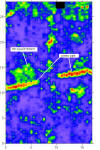 Here we are collecting data with an EM-38 in the fall of 2003.
Here we are collecting data with an EM-38 in the fall of 2003.
 The geophysical maps showed a number of interesting features, including a pipe
to (or from?) the house (there is no documentation of indoor plumbing) and a
trash midden.
The geophysical maps showed a number of interesting features, including a pipe
to (or from?) the house (there is no documentation of indoor plumbing) and a
trash midden.
Historic archaeology using GPR and EM (Electromagnetic Conductivity)
We have collected many grids of GPR at historic sites, most of which are quite good. Historic features tend to be much more visible than prehistoric structures, because they are more intact, not as deeply buried, and often times have metal objects associated with them. Here are two examples.
Bradford House, Colorado: a
historic house still remains, but there are many questions about whether any of
the outbuildings are still present. The historic photos show there to have
been many structures, but none remains. Here we are collecting data with an EM-38 in the fall of 2003.
Here we are collecting data with an EM-38 in the fall of 2003.
 The geophysical maps showed a number of interesting features, including a pipe
to (or from?) the house (there is no documentation of indoor plumbing) and a
trash midden.
The geophysical maps showed a number of interesting features, including a pipe
to (or from?) the house (there is no documentation of indoor plumbing) and a
trash midden.
Four Mile Historic Park, Colorado: this park, 4
miles southeast of downtown Denver, contains the oldest house in the city.
We explored around it to see what might be left of the outbuildings, and found
an interesting square structure in the orchard.
 .
In the profiles the floor is just barely visible, but the pipe can be readily
seen.
.
In the profiles the floor is just barely visible, but the pipe can be readily
seen. .
We excavated it in May, 2003 and found the pipe easily. It was a recent
plastic water pipe. The floor was found to be just a 3 cm thick sand layer
that was probably a base for a flagstone floor. One small piece of
flagstone was found on the sand layer, but the rest appear to have been pulled
up to recycle when the structure was abandoned. This is an interesting
example because it shows how GPR is capable of locating these kinds of subtle
features that are barely visible to the human eye. In fact, when we
excavated it, if we didn't know it was there and were looking for the floor, we
would have just thought it was a sandy layer in the ground, and not paid much
attention to it!
.
We excavated it in May, 2003 and found the pipe easily. It was a recent
plastic water pipe. The floor was found to be just a 3 cm thick sand layer
that was probably a base for a flagstone floor. One small piece of
flagstone was found on the sand layer, but the rest appear to have been pulled
up to recycle when the structure was abandoned. This is an interesting
example because it shows how GPR is capable of locating these kinds of subtle
features that are barely visible to the human eye. In fact, when we
excavated it, if we didn't know it was there and were looking for the floor, we
would have just thought it was a sandy layer in the ground, and not paid much
attention to it!
The Ferry House: Whidbey Island, Washington
This old house had a number of interesting features surround
it, including the old well, and a pile of metal out in a field, that we don't
know the origin of. Also, there were some really interesting prehistoric features visible in the
data, including roasting pits.
Also, there were some really interesting prehistoric features visible in the
data, including roasting pits.![]()